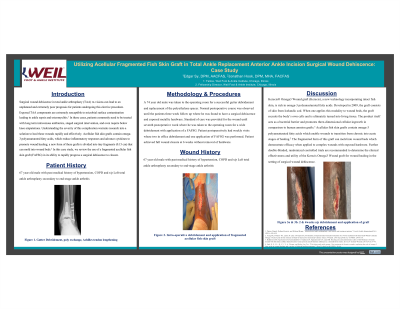Case Series/Study
(CS-143) Utilizing Acellular Fragmented Fish Skin Graft in Total Ankle Replacement Anterior Ankle Incision Surgical Wound Dehiscence: Case Study

Methods:
A 74 year old male was taken to the operating room for a successful gutter debridement and replacement of the polyethylene spacer. Normal postoperative course was observed until the patients three week follow up where he was found to have a surgical dehiscence and exposed metallic hardware. Standard of care was provided for the wound until seventh postoperative week where he was taken to the operating room for a wide debridement with application of a FAFSG. Patient postoperatively had weekly visits where two in office debridement and one application of FAFSG was performed. Patient achieved full wound closure at 6 weeks without removal of hardware.
Results: Patient achieved full wound closure at 6 weeks without removal of hardware
Discussion: Kerecis is rich in omega-3 polyunsaturated fatty acids. The product itself acts as a bacterial barrier and promotes three-dimensional cellular ingrowth in comparison to human amnion grafts. The fragmented form of this graft can mold into wound beds which demonstrate efficacy when applied to complex wounds with exposed hardware.
Trademarked Items:
References: 1. Patton, Daniel, Nathan Kiewiet, and Michael Brage. “Infected total ankle arthroplasty: risk factors and treatment options.” Foot & Ankle International 36.6 (2015): 626-634.
2. Yang CK, Polanco TO, Lantis JC 2nd. A Prospective, Postmarket, Compassionate Clinical Evaluation of a Novel Acellular Fish-skin Graft Which Contains Omega-3 Fatty Acids for the Closure of Hard-to-heal Lower Extremity Chronic Ulcers. Wounds. 2016 Apr;28(4):112-8. PMID: 27071138.
3. Baldursson BT, Kjartansson H, Konradsdottir F, Gudnason P, Sigurjonsson GF, Lund SH. Healing rate and autoimmune safety of full-thickness wounds treated with fish skin acellular dermal matrix versus porcine small-intestine submucosa: a noninferiority study. Int J Low Extrem Wounds. 2015;14(1):37-43.

.png)